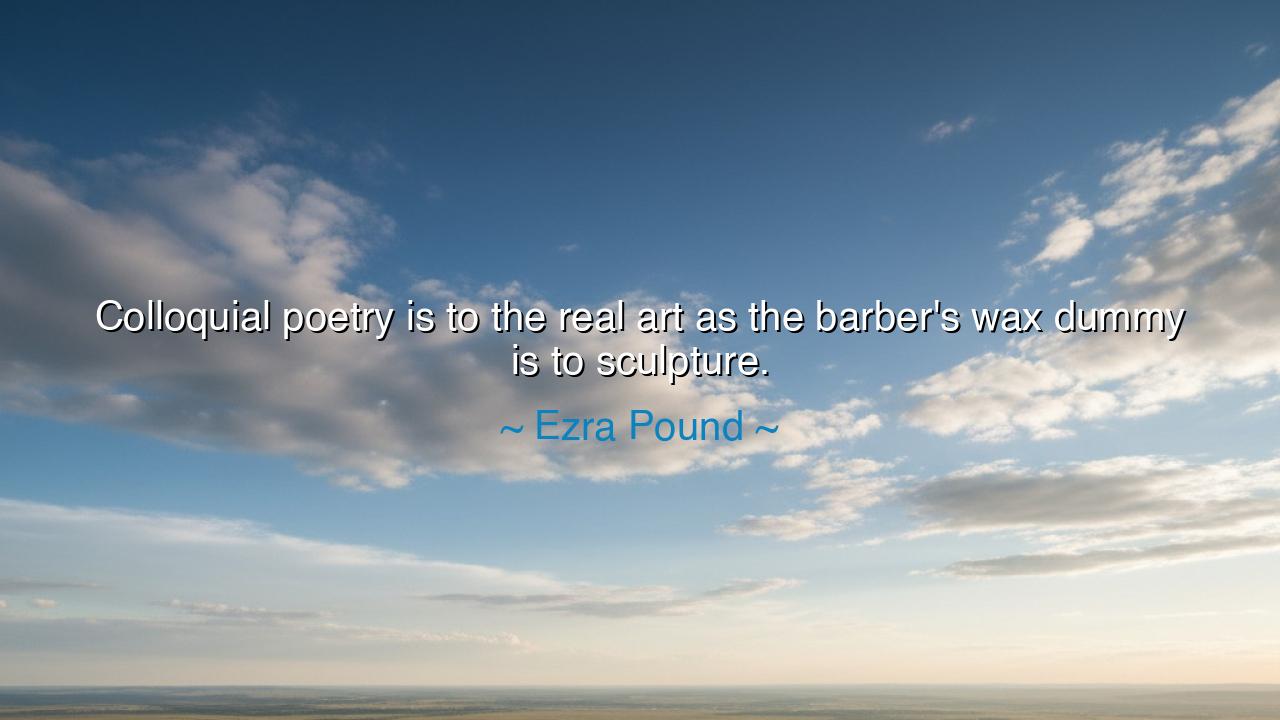
Colloquial poetry is to the real art as the barber's wax dummy






“Colloquial poetry is to the real art as the barber’s wax dummy is to sculpture.” Thus thundered Ezra Pound, prophet of modernism, who demanded from poets not the imitation of speech alone, but the chiseling of words into forms that endure. His simile is harsh and uncompromising: just as the wax dummy in a barber’s shop may mimic the human head but lacks the life and depth of true sculpture, so too, in his eyes, does colloquial verse mimic poetry without achieving its grandeur.
The meaning of this saying rests in the distinction between the casual and the crafted. Colloquial poetry, in Pound’s critique, is writing that merely records the sounds of everyday talk without transforming them into something greater. It may look like poetry on the surface, just as a wax dummy looks like a head, but it lacks the depth, the tension, the sculptural integrity that comes when words are carved with discipline. Real art, he insists, must go beyond mere surface resemblance; it must embody vision, structure, and permanence.
The origin of this belief lies in Pound’s mission as a leader of modernist poetry. In an age where many writers experimented with looser forms, he called for precision and rigor. His cry of “make it new” was not an invitation to carelessness, but to renewal through discipline—language sharpened, images exact, form alive. He saw in careless colloquialism a danger: that poetry would collapse into mere chatter, forgetting its role as the sculpture of language, the shaping of thought into lasting form.
History offers many mirrors of this struggle. In ancient Greece, Homer did not merely transcribe how shepherds spoke; he elevated their tales into epics whose rhythms and metaphors have lasted for millennia. Likewise, Michelangelo’s David is not a mere copy of a man’s body, but a form so alive that it surpasses life itself. These works remind us that art requires transformation: the raw material of speech or flesh must be shaped, refined, made enduring. That is what Pound demands from poetry—no wax dummies, but sculpture in stone.
Yet the lesson is not to reject colloquial language entirely. Even Pound himself used the rhythms of modern speech, but he tempered them with artistry, like a sculptor shaping raw clay into beauty. The warning is against laziness: against mistaking ease for greatness, imitation for creation. Poetry must be more than a mirror of conversation; it must be the carving of experience into a form that others can live with, return to, and find new meaning in long after the voice has fallen silent.
Practically, this calls upon poets and all creators to labor with seriousness. If you write, do not settle for the wax dummy of convenience. Revise, refine, chisel away until what remains has weight and presence. If you live, do not settle for surface appearances, but strive to sculpt your days with meaning and purpose. Excellence, in art and in life, requires the same devotion to form and substance.
Thus the teaching endures: colloquial poetry may amuse for a moment, like the barber’s dummy, but true art—like true sculpture—endures across ages. Ezra Pound’s harsh metaphor is a call to courage: do not imitate life in wax, but carve it into stone. Let your words, your deeds, your art be more than likenesses; let them be living monuments of truth. For only then will they stand, not for a season, but for eternity.






BDHuynh Vuong Bao Dung
Pound’s analogy is fascinating but also a bit harsh. The idea of colloquial poetry being like a wax dummy to sculpture implies that it’s an incomplete or shallow form of expression. But I wonder—could colloquial poetry be a stepping stone to deeper forms of art, or does it always fall short in comparison? Is there room for both complex, structured poetry and simpler, colloquial expressions in the world of true art?
KVKhue Vo
Pound’s critique of colloquial poetry raises some interesting points. He seems to argue that true art requires a certain level of technical mastery, much like sculpture requires skill with materials. But doesn’t this overlook the role that accessibility and emotional impact play in art? Can a poem be deeply moving even if it uses simple, everyday language? What makes something truly artistic—complexity or connection?
VLVan Le
I’m intrigued by Pound’s statement, especially his comparison of colloquial poetry to a wax dummy. It seems to suggest that colloquial poetry is just a surface-level imitation of something much deeper. But I’m curious—does poetry have to be complex or formal to be considered true art, or can the beauty of simplicity and relatability also be a form of artistic expression? How do we define the line between art and imitation in poetry?
KVDam Khanh Vy
Ezra Pound’s comparison between colloquial poetry and real art really struck me. It seems like he’s saying that colloquial poetry, while accessible, lacks the depth and craftsmanship of true poetic art. But I wonder, is that a fair comparison? Does using everyday language in poetry necessarily diminish its artistic value, or can it still convey profound meaning in its simplicity? Could the true art in poetry sometimes lie in its accessibility?